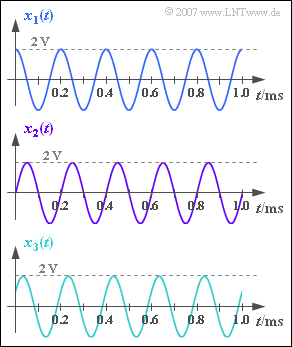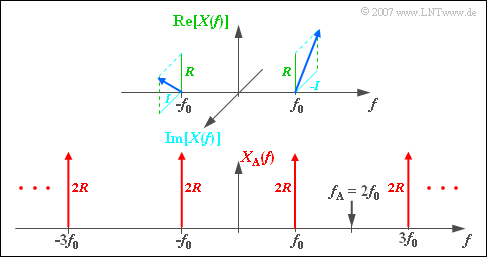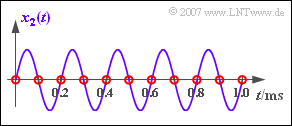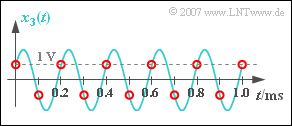Difference between revisions of "Aufgaben:Exercise 5.1Z: Sampling of Harmonic Oscillations"
m (Oezdemir moved page Aufgabe 5.1Z: Abtastung harmonischer Schwingungen to Exercise 5.1Z: Sampling of Harmonic Oscillations) |
|||
| Line 3: | Line 3: | ||
}} | }} | ||
| − | [[File:P_ID1129__Sig_Z_5_1.png|right|frame| | + | [[File:P_ID1129__Sig_Z_5_1.png|right|frame|Three harmonic oscillations of equal frequency $f_0$ and equal amplitude $A$]] |
| − | + | We consider three harmonic oscillations with the same frequency and the same amplitude: | |
:$$x_1(t) = A \cdot \cos (2 \pi \cdot f_0 \cdot t) \hspace{0.05cm}, $$ | :$$x_1(t) = A \cdot \cos (2 \pi \cdot f_0 \cdot t) \hspace{0.05cm}, $$ | ||
:$$ x_2(t) = A \cdot \sin (2 \pi \cdot f_0 \cdot t) \hspace{0.05cm}, $$ | :$$ x_2(t) = A \cdot \sin (2 \pi \cdot f_0 \cdot t) \hspace{0.05cm}, $$ | ||
:$$ x_3(t) = A \cdot \cos (2 \pi \cdot f_0 \cdot t - 60^{\circ}) \hspace{0.05cm}.$$ | :$$ x_3(t) = A \cdot \cos (2 \pi \cdot f_0 \cdot t - 60^{\circ}) \hspace{0.05cm}.$$ | ||
| − | + | The oscillation parameters $f_0$ and $A$ can be taken from the graph. | |
| − | + | It is assumed that the signals are sampled equidistantly at the times $\nu \cdot T_{\rm A}$ , whereby the parameter values $T_{\rm A} = 80 \ µ \text{s}$ and $T_{\rm A} = 100 \ µ \text{s}$ are to be analysed. | |
| − | + | The signal reconstruction at the receiver is carried out by a low-pass filter $H(f)$, which forms the signal $y_{\rm A}(t) = x_{\rm A}(t)$ from the sampled signal $y(t)$ . It applies: | |
:$$H(f) = \left\{ \begin{array}{c} 1 \\ 0.5 \\ | :$$H(f) = \left\{ \begin{array}{c} 1 \\ 0.5 \\ | ||
0 \\ \end{array} \right.\quad | 0 \\ \end{array} \right.\quad | ||
| Line 22: | Line 22: | ||
|f| > f_{\rm G} \hspace{0.05cm}, \\ | |f| > f_{\rm G} \hspace{0.05cm}, \\ | ||
\end{array}$$ | \end{array}$$ | ||
| − | + | Here $f_{\rm G}$ indicates the cut-off frequency of the rectangular low-pass filter. For this shall apply: | |
:$$f_{\rm G} = \frac{1}{ 2 \cdot T_{\rm A}}\hspace{0.05cm}.$$ | :$$f_{\rm G} = \frac{1}{ 2 \cdot T_{\rm A}}\hspace{0.05cm}.$$ | ||
| − | + | The sampling theorem is fulfilled if $y(t) = x(t)$ holds. | |
| Line 31: | Line 31: | ||
| − | '' | + | ''Hints:'' |
| − | * | + | *This task belongs to the chapter [[Signal_Representation/Time_Discrete_Signal_Representation|Time Discrete Signal Representation]]. |
| − | * | + | *There is an interactive applet for the topic dealt with here: [[Applets:Abtastung_periodischer_Signale_und_Signalrekonstruktion_(Applet)|Abtastung periodischer Signale & Signalrekonstruktion]] |
| − | === | + | |
| + | ===Questions=== | ||
<quiz display=simple> | <quiz display=simple> | ||
| Line 72: | Line 73: | ||
</quiz> | </quiz> | ||
| − | === | + | ===Solution=== |
{{ML-Kopf}} | {{ML-Kopf}} | ||
| − | '''(1)''' | + | '''(1)''' The graph shows the amplitude $\underline{A = 2\ \text{V}}$ and the period $T_0 = 0.2 \ \text{ms}$. |
| − | * | + | *This results in the signal frequency $f_0 = 1/T_0 \; \underline{= 5 \ \text{kHz}}$. |
| − | '''(2)''' | + | '''(2)''' <u>All proposed solutions</u> are correct: |
| − | * | + | *The sampling rate here is $f_{\rm A} = 1/T_{\rm A} = 12.5 \ \text{kHz}$. |
| − | * | + | *This value is greater than $2 \cdot f_0 = 10 \ \text{kHz}$. |
| − | * | + | *Thus the sampling theorem is fulfilled independently of the phase and $y(t) = x(t)$ always applies. |
| − | [[File:P_ID1130__Sig_Z_5_1_c.png|right|frame| | + | [[File:P_ID1130__Sig_Z_5_1_c.png|right|frame|Spectrum $X_{\rm A}(f)$ of the sampled signal - real part and imaginary part.]] |
'''(3)''' Die Abtastrate beträgt nun $f_{\rm A} = 2 \cdot f_0 = 10 \ \text{kHz}$. | '''(3)''' Die Abtastrate beträgt nun $f_{\rm A} = 2 \cdot f_0 = 10 \ \text{kHz}$. | ||
| − | * | + | *Only in the special case of the cosine signal is the sampling theorem now satisfied and it holds: |
:$$y_1(t) = x_1(t) ⇒ A_1 \; \underline{=2 \ \text{V}} \text{ und }\varphi_1 \; \underline{= 0}.$$ | :$$y_1(t) = x_1(t) ⇒ A_1 \; \underline{=2 \ \text{V}} \text{ und }\varphi_1 \; \underline{= 0}.$$ | ||
| − | + | This result is now to be derived mathematically, whereby a phase $\varphi$ in the input signal is already taken into account with regard to the remaining subtasks: | |
:$$x(t) = A \cdot \cos (2 \pi \cdot f_0 \cdot t - \varphi) | :$$x(t) = A \cdot \cos (2 \pi \cdot f_0 \cdot t - \varphi) | ||
\hspace{0.05cm}.$$ | \hspace{0.05cm}.$$ | ||
| − | * | + | *Then, for the spectral function sketched in the graph above: |
:$$X(f) = {A}/{2} \hspace{0.05cm} \cdot \hspace{0.05cm} {\rm e}^{{\rm j} \hspace{0.05cm} | :$$X(f) = {A}/{2} \hspace{0.05cm} \cdot \hspace{0.05cm} {\rm e}^{{\rm j} \hspace{0.05cm} | ||
\cdot \hspace{0.05cm} \varphi} \cdot \delta | \cdot \hspace{0.05cm} \varphi} \cdot \delta | ||
| Line 122: | Line 123: | ||
*Die Fourierrücktransformation führt auf | *Die Fourierrücktransformation führt auf | ||
| − | [[File:P_ID1131__Sig_Z_5_1_d.png|right|frame| | + | [[File:P_ID1131__Sig_Z_5_1_d.png|right|frame|Reconstruction of the sampled sinusoidal signal]] |
:$$y(t) = A \cdot \cos (\varphi)\cdot \cos (2 \pi \cdot f_0 \cdot t ) | :$$y(t) = A \cdot \cos (\varphi)\cdot \cos (2 \pi \cdot f_0 \cdot t ) | ||
\hspace{0.05cm}.$$ | \hspace{0.05cm}.$$ | ||
Revision as of 13:27, 1 March 2021
We consider three harmonic oscillations with the same frequency and the same amplitude:
- $$x_1(t) = A \cdot \cos (2 \pi \cdot f_0 \cdot t) \hspace{0.05cm}, $$
- $$ x_2(t) = A \cdot \sin (2 \pi \cdot f_0 \cdot t) \hspace{0.05cm}, $$
- $$ x_3(t) = A \cdot \cos (2 \pi \cdot f_0 \cdot t - 60^{\circ}) \hspace{0.05cm}.$$
The oscillation parameters $f_0$ and $A$ can be taken from the graph.
It is assumed that the signals are sampled equidistantly at the times $\nu \cdot T_{\rm A}$ , whereby the parameter values $T_{\rm A} = 80 \ µ \text{s}$ and $T_{\rm A} = 100 \ µ \text{s}$ are to be analysed.
The signal reconstruction at the receiver is carried out by a low-pass filter $H(f)$, which forms the signal $y_{\rm A}(t) = x_{\rm A}(t)$ from the sampled signal $y(t)$ . It applies:
- $$H(f) = \left\{ \begin{array}{c} 1 \\ 0.5 \\ 0 \\ \end{array} \right.\quad \begin{array}{*{5}c} {\rm{{\rm{f\ddot{u}r}}}} \\ {\rm{{\rm{f\ddot{u}r}}}} \\ {\rm{{\rm{f\ddot{u}r}}}} \\ \end{array}\begin{array}{*{5}c} |f| < f_{\rm G} \hspace{0.05cm}, \\ |f| = f_{\rm G} \hspace{0.05cm}, \\ |f| > f_{\rm G} \hspace{0.05cm}, \\ \end{array}$$
Here $f_{\rm G}$ indicates the cut-off frequency of the rectangular low-pass filter. For this shall apply:
- $$f_{\rm G} = \frac{1}{ 2 \cdot T_{\rm A}}\hspace{0.05cm}.$$
The sampling theorem is fulfilled if $y(t) = x(t)$ holds.
Hints:
- This task belongs to the chapter Time Discrete Signal Representation.
- There is an interactive applet for the topic dealt with here: Abtastung periodischer Signale & Signalrekonstruktion
Questions
Solution
- This results in the signal frequency $f_0 = 1/T_0 \; \underline{= 5 \ \text{kHz}}$.
(2) All proposed solutions are correct:
- The sampling rate here is $f_{\rm A} = 1/T_{\rm A} = 12.5 \ \text{kHz}$.
- This value is greater than $2 \cdot f_0 = 10 \ \text{kHz}$.
- Thus the sampling theorem is fulfilled independently of the phase and $y(t) = x(t)$ always applies.
(3) Die Abtastrate beträgt nun $f_{\rm A} = 2 \cdot f_0 = 10 \ \text{kHz}$.
- Only in the special case of the cosine signal is the sampling theorem now satisfied and it holds:
- $$y_1(t) = x_1(t) ⇒ A_1 \; \underline{=2 \ \text{V}} \text{ und }\varphi_1 \; \underline{= 0}.$$
This result is now to be derived mathematically, whereby a phase $\varphi$ in the input signal is already taken into account with regard to the remaining subtasks:
- $$x(t) = A \cdot \cos (2 \pi \cdot f_0 \cdot t - \varphi) \hspace{0.05cm}.$$
- Then, for the spectral function sketched in the graph above:
- $$X(f) = {A}/{2} \hspace{0.05cm} \cdot \hspace{0.05cm} {\rm e}^{{\rm j} \hspace{0.05cm} \cdot \hspace{0.05cm} \varphi} \cdot \delta (f+ f_{\rm 0} ) + {A}/{2} \hspace{0.05cm} \cdot \hspace{0.05cm} {\rm e}^{-{\rm j} \hspace{0.05cm} \cdot \hspace{0.05cm} \varphi} \cdot \delta (f- f_{\rm 0} )\hspace{0.05cm}.$$
- Mit den Abkürzungen
- $$R = {A}/{2} \hspace{0.05cm} \cdot \hspace{0.05cm} \cos(\varphi) \hspace{0.5cm}{\rm und} \hspace{0.5cm}I ={A}/{2} \hspace{0.05cm} \cdot \hspace{0.05cm} \sin(\varphi)$$
- kann hierfür auch geschrieben werden:
- $$X(f) = (R + {\rm j} \cdot I) \cdot \delta (f+ f_{\rm 0} ) + (R - {\rm j} \cdot I) \cdot \delta (f- f_{\rm 0} )\hspace{0.05cm}.$$
- Das Spektrum des mit $f_{\rm A} = 2f_0$ abgetasteten Signals $x_{\rm A}(t)$ lautet somit:
- $$X_{\rm A}(f) = \sum_{\mu = - \infty }^{+\infty} X (f- \mu \cdot f_{\rm A}
)= \sum_{\mu = - \infty }^{+\infty} X (f- 2\mu \cdot f_{\rm 0}
)\hspace{0.05cm}.$$
- Die untere Grafik zeigt, dass $X_{\rm A}(f)$ aus Diracfunktionen bei $\pm f_0$, $\pm 3f_0$, $\pm 5f_0$, usw. besteht.
- Alle Gewichte sind rein reell und gleich $2 \cdot R$.
- Die Imaginärteile des periodisch fortgesetzten Spektrums heben sich auf.
- Berücksichtigt man weiter den rechteckförmigen Tiefpass, dessen Grenzfrequenz exakt bei $f_{\rm G} = f_0$ liegt, sowie $H(f_{\rm G}) = 0.5$, so erhält man für das Spektrum nach der Signalrekonstruktion:
- $$Y(f) = R \cdot \delta (f+ f_{\rm 0} ) + R \cdot \delta (f- f_{\rm 0} )\hspace{0.05cm}, \hspace{0.5cm} R = {A}/{2} \hspace{0.05cm} \cdot \hspace{0.05cm} \cos(\varphi)\hspace{0.05cm}.$$
- Die Fourierrücktransformation führt auf
- $$y(t) = A \cdot \cos (\varphi)\cdot \cos (2 \pi \cdot f_0 \cdot t ) \hspace{0.05cm}.$$
- Es ergibt sich also unabhängig von der Eingangsphase $\varphi$ ein cosinusförmiger Verlauf.
- Ist $\varphi = 0$ wie beim Signal $x_1(t)$, so ist auch die Amplitude des Ausgangssignals gleich $A$.
(4) Das Sinussignal hat die Phase $90^\circ$.
- Daraus folgt direkt $y_2(t) = 0$ ⇒ Amplitude $\underline{A_2 = 0}$.
- Dieses Ergebnis wird verständlich, wenn man sich die Abtastwerte in der Grafik betrachtet.
- Alle Abtastwerte (rote Kreise) sind Null, so dass auch nach dem Filter kein Signal vorhanden sein kann.
(5) Trotz $\varphi = 60^\circ$ gilt $\varphi_3 = 0$ ⇒ auch das rekonstruierte Signal $y_3(t)$ ist cosinusförmig. Die Amplitude ist gleich
- $$A_3 = A \cdot \cos (60^{\circ})= {A}/{2} \hspace{0.15 cm}\underline{= 1\,{\rm V}} \hspace{0.05cm}.$$
- Wenn Sie die rot eingezeichneten Abtastwerte in der Grafik betrachten, so werden Sie zugeben, dass Sie als „Signalrekonstrukteur” keine andere Entscheidung treffen würden als der Tiefpass.
- Sie kennen ja den türkisfarbenen Verlauf nicht.



